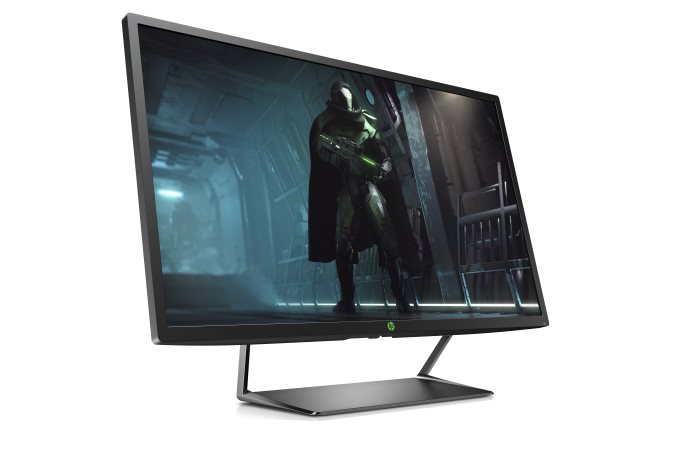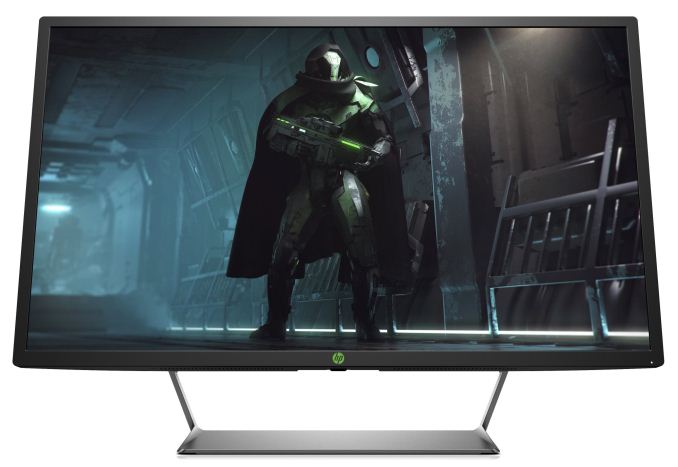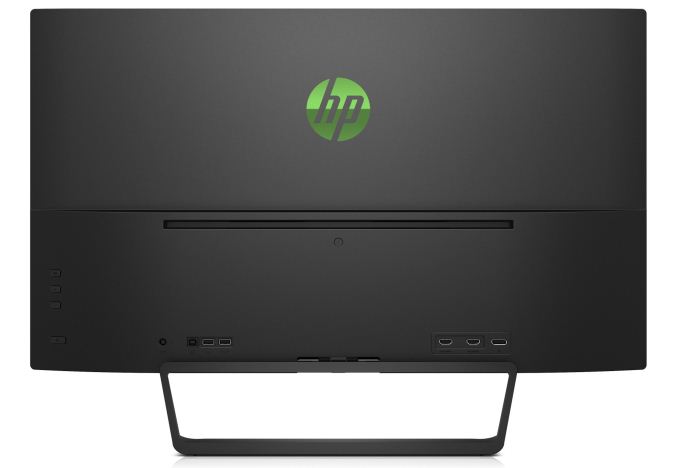HP Announces Pavilion Gaming 32 HDR Display: 32" WQHD w/DisplayHDR 600 & FreeSync
by Joe Shields on April 11, 2018 12:00 PM EST
Alongside their new Pavilion gaming desktops and laptops, today HP is also announcing an addition to their monitor stable with the release of the new Pavilion Gaming 32 HDR Display. An update of sort to HP's current family of 32-inch monitors, including the existing Pavilion Gaming 32 and Omen 32, HP's latest monitor carves out an important niche for itself by adding basic HDR support.
At a high level, the Pavilion Gaming 32 HDR is built on a 32-inch VA panel featuring a 2560x1440 resolution, 300 nits typical brightness, 3000:1 contrast ratio, 5ms response times, and like many of HP's other 32-inch monitors, is FreeSync (1) enabled. The all-important backlighting system being used to enable HDR is an edge-lit LED system that, like similar systems, supports eight different zones of local dimming for increased contrast.
The chassis of the monitor comes in one color, Shadow Black. About the most identifiable feature is the stand that supports the panel. Instead of a circular base with a single post, HP is using a rectangle shaped base with two posts which should make for more stable footing. The back of the monitor has a large green HP symbol in the middle of its gentle arched rear panel. Still on the rear but at the bottom, we are able to see the power adapter, two USB 3.0 ports, as well as the two HDMI and single DisplayPort ports. On the far left is where the power, menu, and adjustment buttons which leave the front with a clean aesthetic. The only design features on the front is a smaller HP symbol in green in the center of the bottom bezel, as well as the power LED in the bottom right corner.
Officially this is a DisplayHDR 600-certified monitor. This means that it supports limited/mid-tier HDR features, including 600 nits peak luminescence for brief periods of time. HP rates the typical brightness at just 300 nits, though as a DisplayHDR 600-compliant display it should be able to sustain 350 nits indefinitely. Equally important, on the color gamut side, the DisplayHDR requirements mean that this monitor needs to support DCI-P3, with HP going above and beyond the standard with a 95% DCI-P3 color gamut.
Meanwhile, to earn its gaming credentials, the monitor supports AMD's first-generation FreeSync variable refresh technology. The 48Hz to 75Hz refresh rate isn't quite wide enough to support FreeSync low framerate compensation, but along with allowing at least some variability here, the higher-than-average 75Hz refresh rate does give the monitor an edge in smoothness over standard 60Hz monitors. This also puts the Pavilion Gaming 32 HDR in limited company as it offers both HDR and FreeSync support. Notably, however, this is not a FreeSync 2 display, so it doesn't get to take advantage of AMD's latest technology there.
The HP Pavilion Gaming 32” Display will cost $449 and will be available through HP.com and other retailers such as Amazon on May 11th.
| Specifications of the HP Pavilion Gaming 32 HDR | |
| 3BZ12AA#ABA | |
| Panel | 32" VA |
| Native Resolution | 2560x1440 (WQHD) |
| Refresh Range | 48 -75 Hz |
| Response Time | 5 ms GtG |
| Brightness | 300 cd/m² (typical) 600 cd/m² (peak) |
| Contrast | 3000:1 |
| Viewing Angles | 178°/178° horizontal/vertical |
| Pixel Pitch | 0.276 mm² |
| Pixel Density | 91.8 ppi |
| Display Colors | 16.7 million |
| Color Gamut Support | DCI-P3 95% |
| Inputs | 1 × DisplayPort 2 × HDMI HDCP 1.4/2.2 |
| Stand | Tilt angle: 21° up; 5° down |
| Audio | N/A |
| VESA | 100 × 100 |
| Additional Information | N/A |
Related Reading:
- Dell's Spring Range: New 8th Gen Alienware, Laptops, and Monitors
- LG Introduces New UltraFine 4K and 5K Monitors
- HP Z27q Monitor Review: Aiming For More Pixels
- LG Announces the 5K UltraWide 34WK95U: A 'Nano IPS' Monitor with a HDR600 Badge
- LG Develops ‘Nano IPS’ LCD, Unveils 32UK950 4K Display with DCI-P3, HDR600, TB3
- Dell Previews 27-inch ‘5K’ UltraSharp Monitor: 5120x2880
Source: HP












46 Comments
View All Comments
Simon_Says - Thursday, April 12, 2018 - link
Quick google search says they can, but only in DirectX full screen exclusive modes. Not OpenGL, not desktop. Didn't find info yet regarding Vulkan.It's amazing how badly all these standards and implementations are being developed and released half-baked.
-HDMI 2.0 almost immediately superseded by 2.0a, b and c. 2.1 is just around the corner looking like what 2.0 should have been in the first place.
-VP9 10bit only on Kaby Lake and Raven Ridge but AV1 will be coming out soon to replace it.
-All PC implementations of HDR are HDR10 instead of HDR10+. There's supposedly DolbyVision on Nvidia GPU's but nothing on PC for it?
-And now we're finding out that monitors and cards don't support 10bpc properly.
I guess it's sort of a blessing that hardware is so damn expensive these days, because there's zero point buying any of if you're looking for a proper media experience because it'll all either fall short or be obsolete by year end.
bug77 - Saturday, April 14, 2018 - link
Well, card do support 10bpc properly, but the feature is reserved to professional cards. In part because there was no real need for 10bpc in the consumer space (still isn't, but that's changing) and in part because that is one of the features that make professionals cough up an order of magnitude more $$$ for their cards.sean8102 - Tuesday, July 21, 2020 - link
I know this is old but Nvidia's regular cards have supported 10 bpc since Pascal. My GTX 1080 output 10 bpc. https://i.imgur.com/1BGCag7.pngSttm - Wednesday, April 11, 2018 - link
27 inch 4ks, 32 inch 1440p... this is not how its done people!Flunk - Wednesday, April 11, 2018 - link
This is probably a re-purposed TV panel.DanNeely - Wednesday, April 11, 2018 - link
Yeah, cause there are so many 1440p TVs on the market.faiakes - Wednesday, April 11, 2018 - link
I have a 32" 2560x1440 panel and it's just right.I'm looking at 40"+ for 4K.
p1esk - Wednesday, April 11, 2018 - link
I have 27" 5k panel, and it's just right. I used to have 32" 4k monitor, and it was too large vertically. I'd be open to an 34" ultrawide 5k monitor, if it's curved.Sttm - Wednesday, April 11, 2018 - link
I have a 27 inch 1440, and its just right. I think 32" would seem like going back to my old 27 inch 1080p.And 5k... you have to be using scaling right? How tiny is that text :)
StevoLincolnite - Wednesday, April 11, 2018 - link
I have a 32" 1440P panel and a 27" 1080P panel.The pixel density on the 1440P panel is easily superior.
I like the screen size as I watch allot of media, but I wouldn't mind 120hz. One day I suppose it will be affordable.